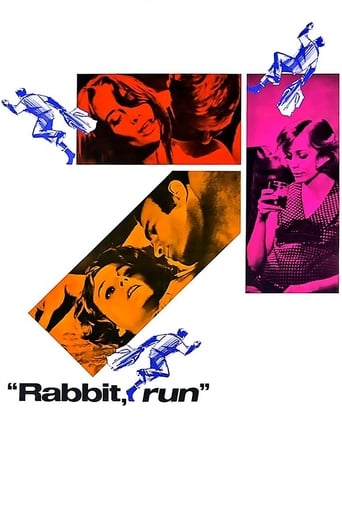Limeginger
Some films pass the test of time. Others feel incredibly stale, dated, and stultifying. This film, I would wager, felt stale as soon as it hit the theatres. James Caan's and most of the other actors' acting is stiff, forced, and one dimensional, and the screen adaptation of a worthwhile book also is awkward and artificial, in the way that films that don't pass the test of time are.As another reviewer remarked, the film was made 10 years too late--the mores and morals of the year 1960 had already completely shifted by 1970, so the film doesn't even make sense, and the film making and directorial style feel unpleasantly anachronistic.
William Reid
Strong performances, especially James Caan at the height of his career, save this film from being a complete disaster. The problem is that the 1950's themes (Updike's novel is set in 1956) seem out of place framed within the 'New Hollywood' of American film making in 1970. Choppy editing and a heavy 70's electronica soundtrack distract from what would otherwise be a fairly strong representation of the new wave of film making (Midnight Cowboy, The Graduate, Bonnie & Clyde) portraying a harsher and more critical view of middle class America. Caan's portrayal of the selfish and immature 'Rabbit' is sympathetic and charming. He is surrounded by a supporting cast that portray hapless, stupid or unlikable people who interfere in his efforts to find fulfillment. These characters are one dimensional and serve only as a means to justify the angst and frustration of the protagonist. (A recurring plot device in the American 'New Wave' cinema.) Worth the watch for fans of Caan or films of that era.
moonspinner55
Jack Smight directed this unexciting adaptation of John Updike's book about a feckless husband and father in small town Pennsylvania, married to a pregnant, alcoholic drudge, who bolts from his responsibilities. Although new to the screen, James Caan does quite well in the central role, turning this flaky material (dotted with shockable language, which was new at the time, and talk of sexual kinks) into an acting showcase. Caan gives his Rabbit a sense of humor bourn of desperation and an edge that isn't so much angry as it is internally combative. Updike, the ultimate girl-ogling, horny heterosexual, doesn't allow his characters to have much fun, and this dampens the movie as well. Smight blamed the poorly-received results on producer-screenwriter Howard B. Kreitsek, who reedited Smight's final cut, and threatened to remove his name from the credits. "Rabbit, Run" isn't terrible but, aside from Caan's casting, it isn't anything memorable or dynamic. Carrie Snodgress is poorly-used as Rabbit's wife, though Jack Albertson (in the basically unplayable role of Rabbit's former basketball coach) gets stuck with the worst of it. *1/2 from ****
Alan J. Jacobs
After I read Rabbit Run and Rabbit Redux, I wanted to see how many Updike novels had been made into movies. His writing does not seem cinematic. I was surprised to find that, in addition to The Witches of Eastwick, Rabbit Run had, in fact, been made into a movie. And starring one of the leading actors of the late 60's, early 70s, James Caan, as well as Carrie Snodgrass, best known for Diary of a Mad Housewife. Also, in a major role, Jack Albertson, later renowned for Chico and the Man.Rabbit Run, the movie, is unfairly neglected. The central role of Harry Angstrom is fully realized by James Caan as a guy you sympathize with and despise. The events of Harry's life are played out to suitably tacky late-60's pop music, and filmed in John Updike's hometown of Reading, Pa. Reading looks even sadder than Updike described it, but the gritty streets work well for the story. They are unpleasant and dangerous and claustrophobic, and if you were to live there, in this small industrial city walled in by high hills, you might feel like you're trapped, like Rabbit was.James Caan was somewhat unique among actors of that time: I think of Dustin Hoffman and Elliot Gould as being the icons of the era, the not-really-handsome lovable Jewish schmos. James Caan is a Jewish schmo, but he's also a hunk, with broad shoulders and a big chest and a seductive face. He's conventionally sexy, and women fall for him easily, but he still is an outsider, he's got issues, lots of issues, just like Dustin and Elliot. A super-schmo.There was one scene in the book, which I will NOT reveal here, that was harrowing and an amazing display of the author's power with his pen. That scene translates frighteningly to the screen, although I thought the filmmakers could have gone much further in depicting the horror. If ever a remake is made, THAT scene should be full-out Grand-Guignol.It's a satisfying flick, and it makes you long for the sequel that was never made. I read elsewhere that this film never even opened in New York, the studio thought so little of it. If the éminences grises of the Film Forum or Anthology Film Archives or Film Society of Lincoln Center are reading this, please consider reviving this film, and giving it a proper New York opening.




